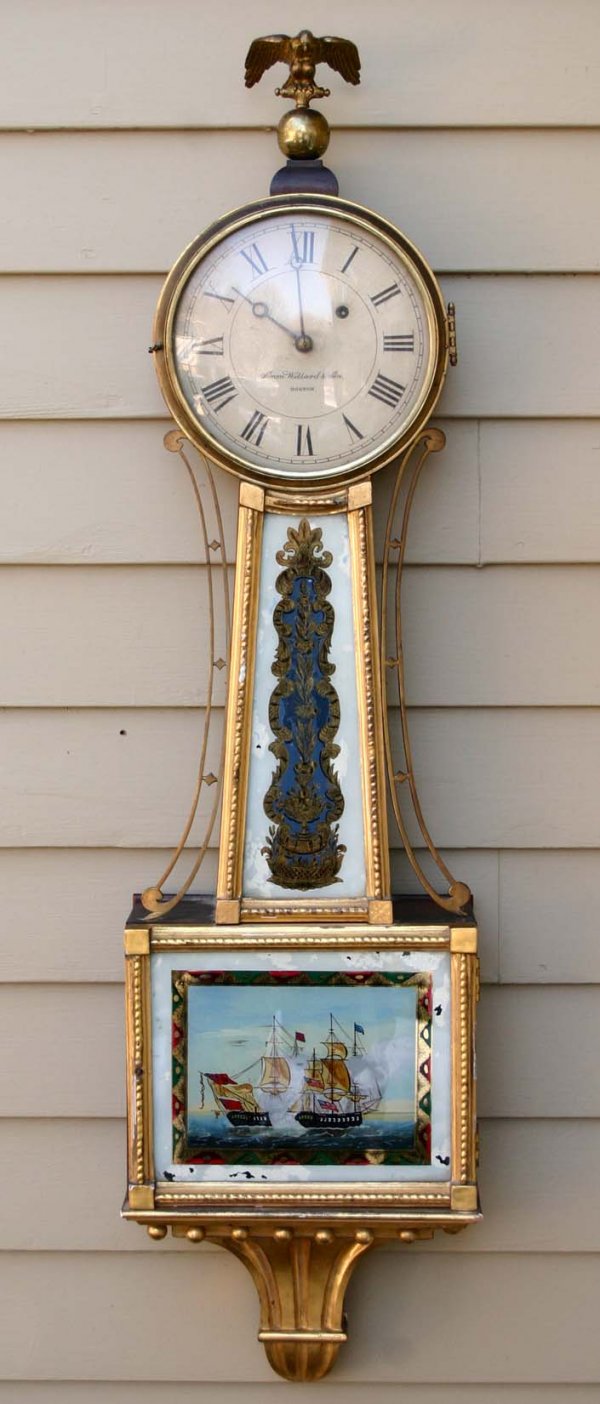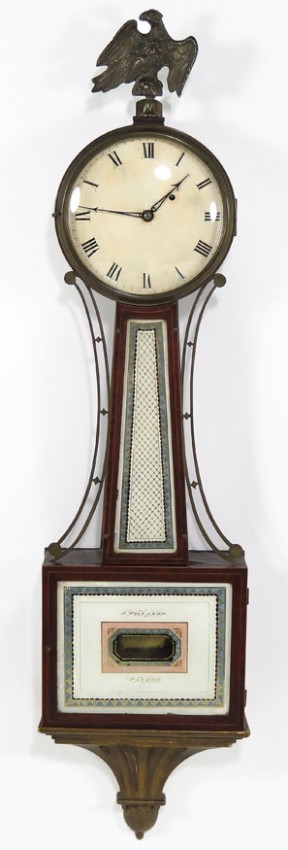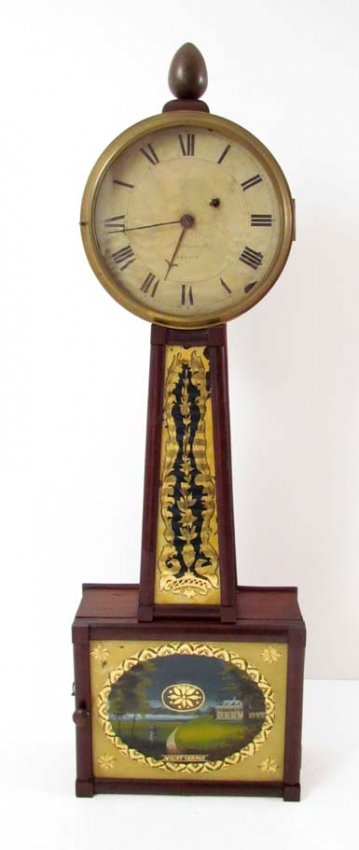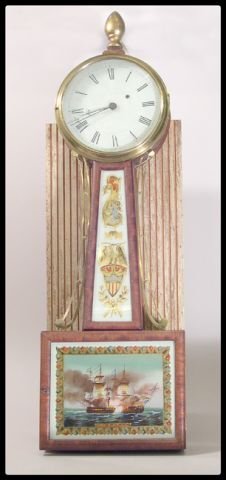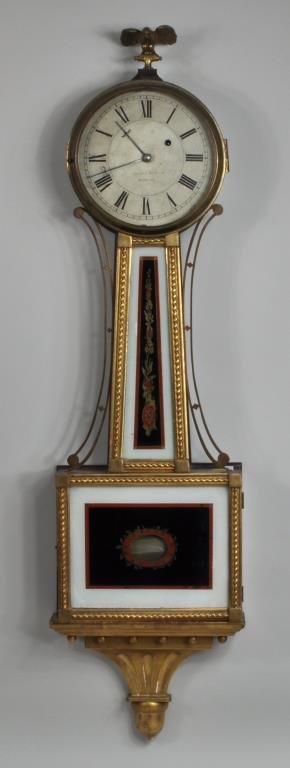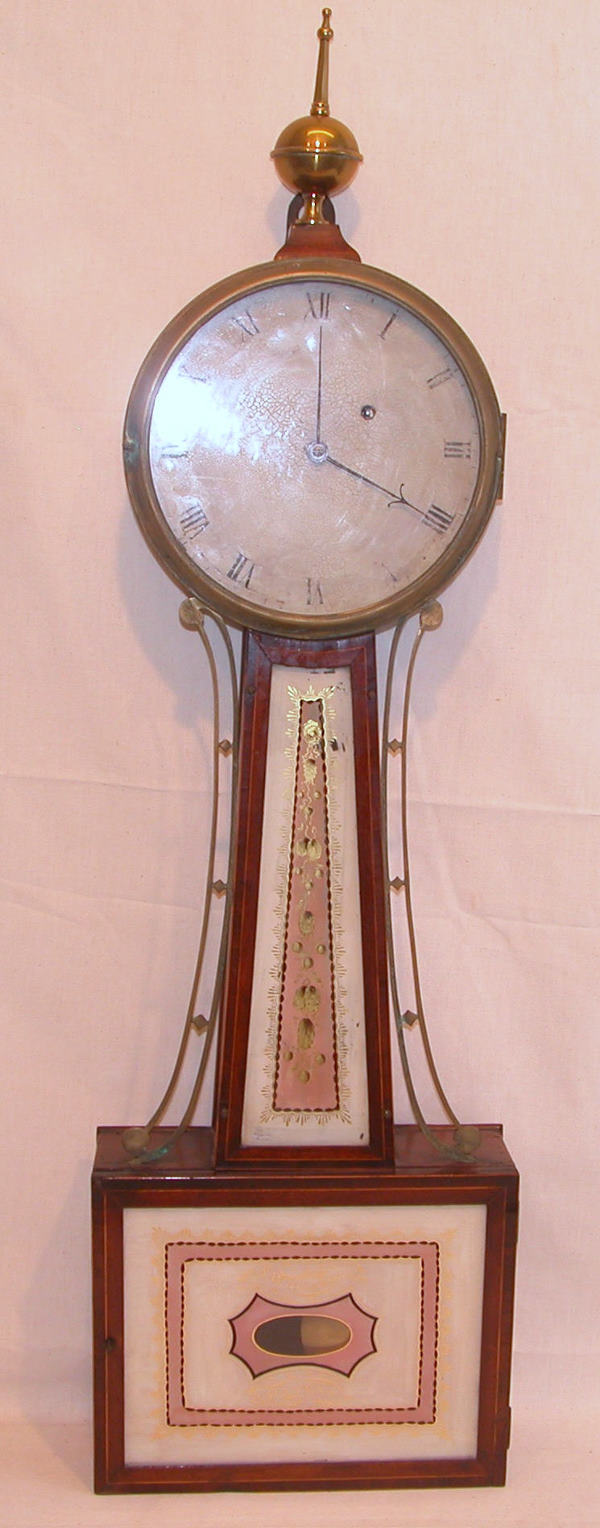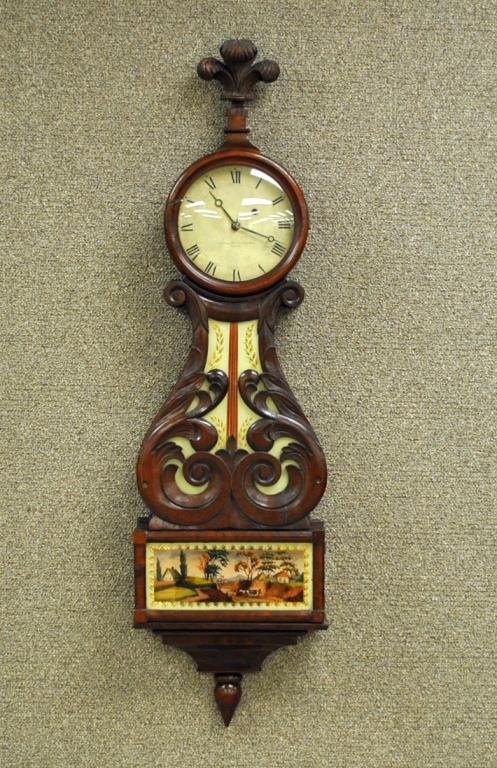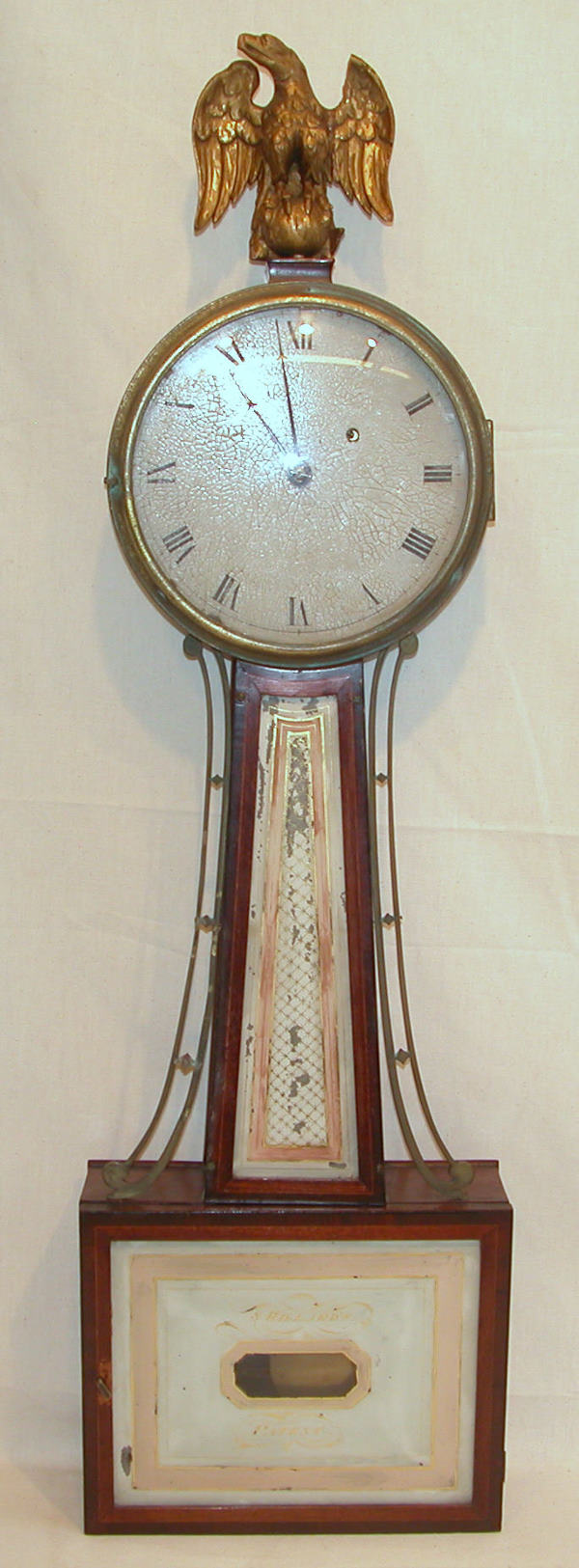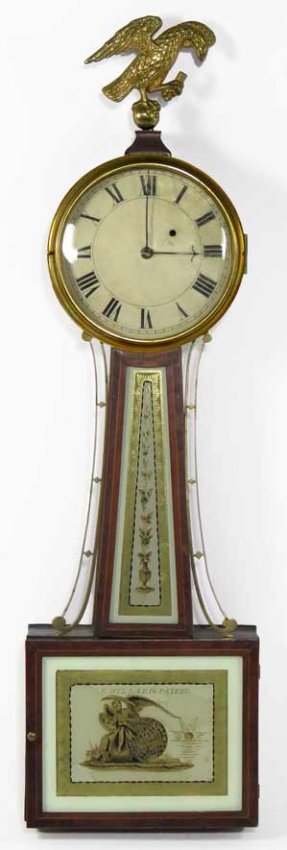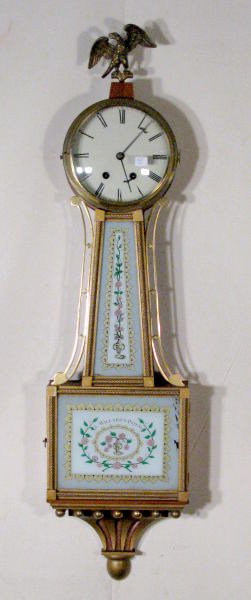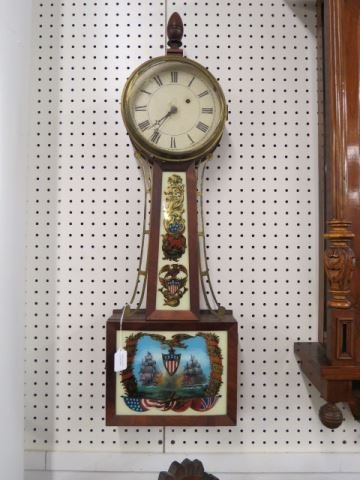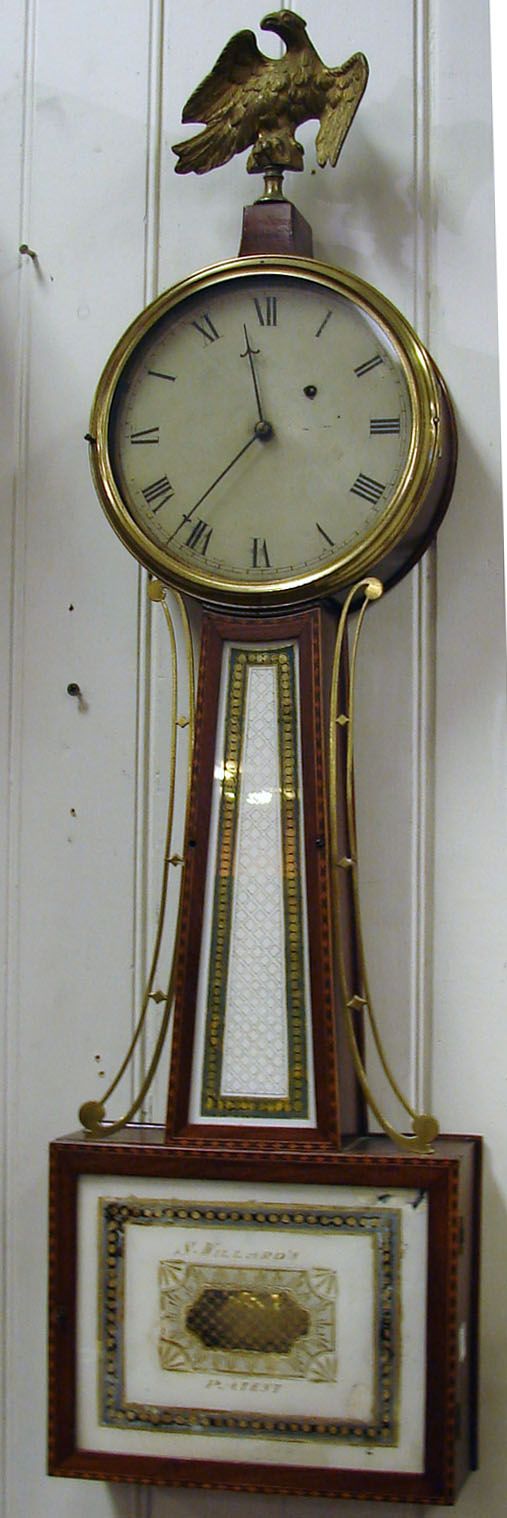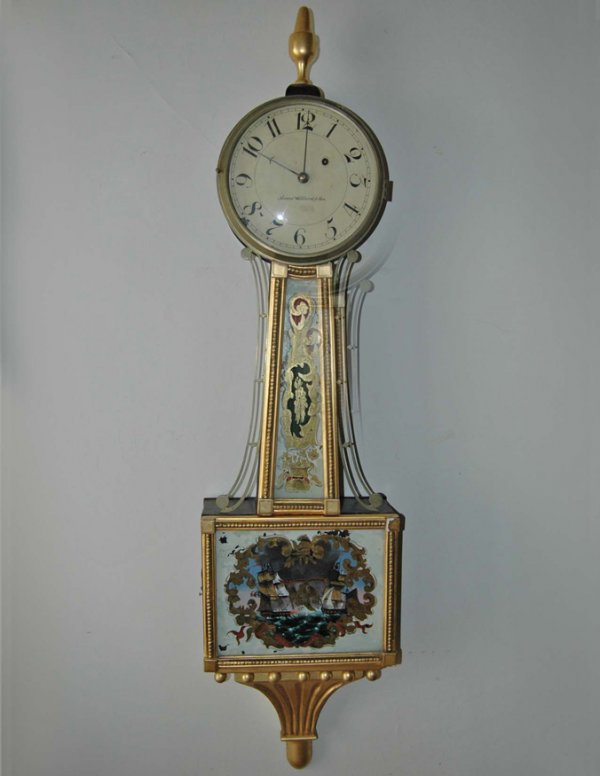Simon Willard American Banjo Clock
Description
Simon Willard American Banjo Clock: time only weight driven with a 7″ original dial. The name Simon Willard, Boston was painted on after the dial already had some good age to it. The movement is early and proper for this case.
(No pendulum ball. The dial’s paint is crazed and has some loss to the paint by the L screws. The gilt paint is original and shows wear in some places. Both glass plates are replacements. The eagle finial is not as old as the case.)
39 1/2″
All items sell As Is, Where Is, no guarantees of any kind. We accept Mastercard & Visa, no paypal, no personal checks, no money orders, no wire transfers. Your credit card will be charged twice; once for the purchase and once for packing and shipping, You, the buyer must contact our office within 3 business days of the auction ending to make payment arrangements. Thank You for participating in our auction.
- Estimate:
- [restrict paid=ture]$100 – $300[/restrict]
- Auctioneer:
- [restrict paid=ture]Tom Harris Auctions[/restrict]
- Sold Price:
- [restrict paid=ture]$2,250[/restrict]
- Sold Date:
- [restrict paid=ture]Jul 21, 2010[/restrict]
Simon Willard Banjo Clock
Description
Weight Driven Banjo Clock, marked Simon Willard & Son Boston. Length 42″ including Finial. Provenance: Frank Allen Estate Beacon St. Boston Ma
- Estimate:
- [restrict paid=ture]$750 – $1,500[/restrict]
- Auctioneer:
- [restrict paid=ture]Carl W. Stinson, Inc. Auctioneers & Appraisers[/restrict]
- Sold Price:
- [restrict paid=ture]$3,750[/restrict]
- Sold Date:
- [restrict paid=ture]Jan 17, 2010[/restrict]
IMPORTANT SIMON WILLARD FEDERAL BANJO CLOCK
Description
Roxbury, Massachusetts, the lower tablet sgn. S. Willard Patent
in old color, T-bridge movement, original glass tablets with gilt cross hatching,
original eagle finial and brass brackets, 36h (not inc. finial)
- Estimate:
- [restrict paid=ture]$20,000 – $30,000[/restrict]
- Auctioneer:
- [restrict paid=ture]CRN Auctions, Inc.[/restrict]
- Sold Price:
- [restrict paid=ture]$20,000[/restrict]
- Sold Date:
- [restrict paid=ture]Jan 29, 2012[/restrict]
Simon Willard Banjo Clock
Description
Roxbury, Massachusetts, early 19th century, mahogany throat and base panel with carved and gilt wood surrounds, panels with leaf and berry blue, cream, gilt and gray-blue decoration, lower panel signed “S. Willard’s Patent”, cast brass eagle finial, with winder, 34-1/2 x 10-1/4 x 4-1/4 in., dial paint restored, privacy label verso “The Dallas House, Georgia, 1985”, throat panel with patch and repairs at attachment to case, reverse-painted panels with retouch, eagle finial replaced, separations and losses to gilt elements, two corner blocks on lower door replaced, pierced brass elements bent, other warping and scattered repairs, stains and scattered losses Provenance: Collection of Mr. and Mrs. Levon C. Register, Franklin Springs, Georgia
- Estimate:
- [restrict paid=ture]$4,000 – $6,000[/restrict]
- Auctioneer:
- [restrict paid=ture]Brunk Auctions[/restrict]
- Sold Price:
- [restrict paid=ture]$11,000[/restrict]
- Sold Date:
- [restrict paid=ture]Nov 13, 2010[/restrict]
Banjo Clock in the style of Simon Willard
Description
S. Willard Sr. with painted inscription on clock face
S. Willard Sr. Banjo Clock with reverse painted glass front of Mt. Vernon
32.25 x 10 x 4 inches
Signed on the clock face
Frances Debroff Collection
Condition
In generally good condition apart from a break in the neck.
- Estimate:
- [restrict paid=ture]$400 – $800[/restrict]
- Auctioneer:
- [restrict paid=ture]Concept Art Gallery[/restrict]
- Sold Price:
- [restrict paid=ture]$1,100[/restrict]
- Sold Date:
- [restrict paid=ture]Oct 26, 2013[/restrict]
Simon Willard Presentation banjo clock.
Description
Simon Willard mahogany eglomise banjo clock. Dial inscribed in India ink verso: ” Presented to Henry Little & Sophia Goodale Wedding October 27, 1816 by Simon Willard, Roxbury” and other notations. Has battle scene between the Boher and the Enterprise, restorations. 33″ x 10″. Restoration to glass and dial, tablets replaced.
- Estimate:
- [restrict paid=ture]$800 – $1,200[/restrict]
- Auctioneer:
- [restrict paid=ture]John McInnis Auctioneers[/restrict]
- Sold Price:
- [restrict paid=ture]$1,100[/restrict]
- Sold Date:
- [restrict paid=ture]May 28, 2004[/restrict]
Simon Willard Federal Mahogany Banjo Wall Clock
Description
Simon Willard Federal mahogany and parcel gilt banjo wall clock, 19th century, with brass eagle finial, painted dial inscribed “Simon Willard Boston” with a reverse painted throat and lower case glass. 39 1/2″ high, 10″ wide. Condition:wear to paint on dial, a few small nicks, losses to gilt wood.
- Estimate:
- [restrict paid=ture]$3,000 – $4,000[/restrict]
- Auctioneer:
- [restrict paid=ture]Schwenke – Woodbury Auction LLC[/restrict]
- Sold Price:
- [restrict paid=ture]$2,500[/restrict]
- Sold Date:
- [restrict paid=ture]Jun 08, 2014[/restrict]
Simon Willard Banjo Clock.
Description
Banjo clock with cross-banded mahogany case accented with line inlay, reverse painted glass panels, brass side arms, brass finials, eight-day brass weight works, by Simon Willard, circa 1810, 34 1/2″t., 10″w., 3 1/2″d. Condition: glasses repainted, minor case restoration, broken hands, finials replaced, added metal plate at back of works.
- Estimate:
- [restrict paid=ture]$6,000 – $8,000[/restrict]
- Auctioneer:
- [restrict paid=ture]Alderfer Auction Company[/restrict]
- Sold Price:
- [restrict paid=ture]$4,750[/restrict]
- Sold Date:
- [restrict paid=ture]Sep 15, 2005[/restrict]
SIMON WILLARD LYRE-FORM FEDERAL BANJO CLOCK
Description
the Roman numeral dial over an eglomise throat piece with gilt foliate and maroon stripes decoration, glazed lower panel depicting a farm scene with gilt surround, carved fleur de lis finial is replacement, acorn base pendant, all painted panels appear to be original, dial signed Simon Willard & Son, Boston, overall complete with unsigned movement, weight and pendulum, old red inventory numbers on right side of pendulum box (43.7.27), minor old restorations to face door surround, 42x12x4in.
- Estimate:
- [restrict paid=ture]$2,000 – $3,000[/restrict]
- Auctioneer:
- [restrict paid=ture]Leighton Galleries[/restrict]
- Sold Price:
- [restrict paid=ture]$2,300[/restrict]
- Sold Date:
- [restrict paid=ture]Sep 04, 2014[/restrict]
Simon Willard Banjo Clock.
Description
Banjo clock of cross-banded mahogany with line inlay, brass side arms, original reverse painted glass tablets, gilt carved wood eagle finial, eight-day weight-driven works, by Simon Willard, circa 1810, marked with cleaning date of January 15, 1870, 34″t., 10″w., 3 1/2″d. Condition: restoration to one side arm, repair to finial, replaced glue blocks, some loss to painted tables.
- Estimate:
- [restrict paid=ture]$20,000 – $25,000[/restrict]
- Auctioneer:
- [restrict paid=ture]Alderfer Auction Company[/restrict]
- Sold Price:
- [restrict paid=ture]$36,000[/restrict]
- Sold Date:
- [restrict paid=ture]Sep 15, 2005[/restrict]
SIMON WILLARD INLAID BANJO CLOCK
Description
on lower tablet, S. Willard Patent,
T-bridge movement, weight driven, 34.5h (incl. finial)
Hurd Family, Milton, Massachusetts
Condition
Restoration to tablets.
- Estimate:
- [restrict paid=ture]$800 – $1,200[/restrict]
- Auctioneer:
- [restrict paid=ture]CRN Auctions, Inc.[/restrict]
- Sold Price:
- [restrict paid=ture]$1,600[/restrict]
- Sold Date:
- [restrict paid=ture]Sep 21, 2014[/restrict]
Replica of a Simon Willard Banjo Clock
Description
Replica of a Simon Willard Banjo Clock: the time and gong striking movement is unmarked. The metal dial is 7 1/2″ wide. Not weight driven.
(Not running. The lower glass paint has some loss in one area.)
41″ long.
All items sell as is, where is, no guarantees of any kind. You, the buyer must call our office within 3 business days after the auction to make payment. We accept Mastercard & Visa, no personal checks, no money orders, no wire transfers. Your card will be charged twice, once for the purchase and once for shipping. Thank You
- Estimate:
- [restrict paid=ture]$500 – $1,500[/restrict]
- Auctioneer:
- [restrict paid=ture]Tom Harris Auctions[/restrict]
- Sold Price:
- [restrict paid=ture]$150[/restrict]
- Sold Date:
- [restrict paid=ture]Oct 04, 2008[/restrict]
Simon Willard Banjo Wall Clock,
Description
reverse painted scene of Parry’s Victoryon Lake Erie, 1813, a top name in clocks, circa 1814, 33″ tall. working….Simon Willard was of the fifth Willard generation in America. The original Willard family had arrived in 1634 from Kent (England), and they were among the founders of Concord, Massachusetts. Simon Willard’s parents were Benjamin Willard and Sarah Brooks, who were Grafton natives. Like all Willard brothers, Simon was born on the family farm, in Grafton, on April 3, 1753. He was the second son; his brothers were Benjamin, Aaron, and Ephraim.The farm, now operated as the Willard House and Clock Museum, had been built in 1718, by the Willards’ third American generation. When Simon Willard was born, the house had just one room. The elder brother Benjamin, who was 10 years older than Simon, learned horology and opened a workshop adjacent to the house in 1766. It is presumed that the other Willard brothers were taught horology by Benjamin.At age 11 Simon began to study horology, showing some inherent ability for it.[citation needed] A year later, senior Benjamin hired the Englishman Mr. Morris, who would teach horology particularly to Simon. Years afterward, Simon revealed that Morris didn’t know much on the matter and his brother Benjamin had been his actual mentor. Just after another year, Simon built his first tall clock.Like some other contemporary horologists, the Willards divided their lives between farm chores and the clock business. The horology became profitable, and Benjamin got a workshop at Lexington, Massachusetts, in 1767. Simon Willard managed his own business in Grafton; nowadays some clocks survive, reading “Simon Willard, Grafton.”At his workshop in Grafton, Willard studied the clocks which were repaired by him. He experimented intensively, to reduce those timepieces’ parts which did the driving and the regulation. The smallest clock was the bracket clock, and Simon invented his gallery clock (which was patented later in 1802) copying this design. The next creation of Simon was the shelf clock, which was based on the gallery clock model.A pioneer American industry[edit]About 1780, Simon Willard moved alone to Boston’s 2196 Roxbury Street (later known as Washington Street), into a four-room workshop. Soon after, Aaron settled in the same neighborhood, a quarter mile away. In 1784, Willard’s workshop advertised: “Simon Willard opened a shop in Roxbury Street, nearly facing the road which turns off to Plymouth. There, Simon Willard carries on the clockmaking business, in all its branches.” Like Aaron, Simon was still interested in perfecting the mechanism of the compact clocks. Nonetheless, since the 1790s, Willard’s workshop built tall clocks in great proportion while performing general clock repair.Both Simon and Aaron Willard combined 18th century knowledge of horology with then-contemporary industrial methods (pre-cast parts, template usage, labor division, standardized production, efficient management). Simon and Aaron Willard each developed an industrial zone, throughout a quarter-mile radius around their shops. By 1807, 20 factories in Boston were sub-contracted to supply parts or materials to the Willard brothers’ businesses. This included mahogany (by some nearby mills), clock parts (amongst which 20 cabinetmakers were), gilder works, and other important artistic resources. Besides, both Willards resorted to the same providers and even to the same workers.English suppliers were also used, as the early United States lacked vital raw materials, most particularly brass. Entire English clock mechanisms, whose performance was much longer with respect to the wooden ones of America, were assembled into the mahogany clock cases of Boston.By their quality, the clocks of Boston became a sign of status. Americans were eager to buy clocks for parlors, offices, churches, or other public spaces. Simon Willard’s clocks were the most famous in America. However, they were still expensive for the common people. Indeed, Simon Willard preferred to build sumptuous models which were full of artistic details (brass touches, mainly). In his belief, the clocks had to be just so expensive that, after acquiring one, the people may be still able to furnish their fine homes.Simon Willard built most clocks through labored handicraft, and these devices were outstandingly precise. Particularly, Simon had quite trained hands and a great eye, filing cogwheels without using marks, whereas such mechanisms worked finely, with a month accuracy of 30 seconds. Although Simon’s workshop produced fewer clocks with respect to Aaron’s, nowadays Simon’s clocks are sold by the highest bids in auctions, by their superior refinement. About 1810, both Simon and Aaron were producing clocks which belonged among the European clock mainstream.Simon Willard interviewed his clients personally, evaluating each detail, and he ordered his technicians to check each device extensively, in the customer’s own home. Into each clock, Simon included brochures, with instructions, a written guarantee, and the assertion of ownership. Further technician service was provided, as well. Although Simon knew little about advertising, he promoted his workshop through papers which were affixed inside the devices. He touted: “These clocks are made in the best manner. They run for a year and they don’t wind up. We will give evidence that it is much cheaper to buy new clocks than to buy old or second hand clocks. Simon Willard warrants all his clocks.” Nonetheless, on some occasions, the signature of Simon Willard was obviated from his clocks.The clocks[edit]A c. 1810 Simon Willard gallery clock in the lobby of the West Wing of the White House.Longcase clocks[edit]Simon Willard built longcase clocks which were quite sumptuous, being adorned with many fine details. These pricey models cost more than 60 dollars during their heyday, the 1790s, to put the amount into today’s dollars, one dollar was an ounce of silver and in 2012 is worth over $40, so just in silver it is a few thousand 2012 dollars.In the most expensive tall clock units, the mahogany cases had a mid-18th century English style and, bearing exactly similar English brass mechanisms all, their case complexity determined their final price. Distinctively for Willard’s workshop, above the clock’s top fretwork, three pedestals were, on which two spherical finials and a large bird figure were mounted. In addition, like Aaron, Simon built a glass dial door, whose top had a half arch shape. Onto the dial, celebrated Boston painters painted different motifs. Also, with few extra mechanism, amusing wheels with animated figures were featured on the dial, enticing the customer interest effectively.During his career, Willard manufactured 1,200 tall models. However, after 1802, in which the gallery clock was finally patented, Simon spurned the manufacture of the tall clock, which was thereafter produced only by special commission.Patent Timepiece, or “banjo” clocks[edit]Simon Willard invented the Patent Timepiece, later called the “banjo” clock, at Roxbury. It was America’s first commercially successful wall clock. It was an innovative design. It was the first American eight-day wall clock, the first American wallclock to have the pendulum suspended in front of the weight in the case, and the first American wallclock to have the weight attached to a pulley. The brass clock mechanism was reduced to a much smaller size, therefore saving brass which was in scarce supply in the early 19th century. Its shape was an imitation of the traditional wheel barometers. Early Patent Timepieces were built by hand, to order. By 1805 the clockworks, and standard cases, could be produced in quantity, reducing the cost of the clock.Its small size meant a much lower price of 30 dollars, although this was still a large amount of money. Nonetheless, while American consumerism was arising, Simon’s Patent Timepiece revolutionized the clock industry, becoming the most popular clock in the United States, whereas Europe lacked some counterpart of it.Willard patented its creation quite late (1802) but most competitors of Simon dodged this document, reaping much money with their own versions of the Patent Timepiece. However, Simon never filed a demand against such usage. After 1802, in Simon’s workshop, the smaller Banjo and shelf clocks were the bread and butter models while Simon pursued his other great projects, throughout the United States. Eventually, Willard’s workshop manufactured 4,000 small timepieces (Banjo and shelf clocks).Since its patenting, the Patent Timepiece remained with the same original design. Typically, they were surrounded by glass tablets, which were reversely painted with neoclassical motifs. Additionally, Willard expanded the Banjo clock in accordance with the patent, making much larger “seconds beating” regulators.The shelf clock[edit]Before creating the Banjo model, Simon designed a shelf clock (1780s, Grafton). It was similar to the tall model, with its original hood and base, but lacking its middle body. The shortened shelf clocks had lower prices, too, and they were commercially successful. Shelf models were produced until approximately 1830.
- Estimate:
- [restrict paid=ture]$500 – $800[/restrict]
- Auctioneer:
- [restrict paid=ture]Richard D. Hatch & Associates[/restrict]
- Sold Price:
- [restrict paid=ture]$325[/restrict]
- Sold Date:
- [restrict paid=ture]Sep 27, 2014[/restrict]
Simon Willard Banjo Clock
Description
Circa 1810, 8 day weight-driven works, inlaid mahogany case, gilt metal American eagle finial, circular glazed dial door with brass mount, glazed throat panel with reverse-painted gold on white lattice motif and gilt bead border flanked by twin curved brass brackets. Reverse-painted glazed pendulum door with latticework reserve marker S. Willards/PATENT., 35t. (including finial), 9 5/8 w., 3 ½d. Condition some reverse paint damage to gilt bead border on pendulum door.
- Estimate:
- [restrict paid=ture]$1,200 – $1,800[/restrict]
- Auctioneer:
- [restrict paid=ture]Alderfer Auction Company[/restrict]
- Sold Price:
- [restrict paid=ture]$12,000[/restrict]
- Sold Date:
- [restrict paid=ture]Dec 08, 2007[/restrict]
SIMON WILLARD 43″ BANJO CLOCK
Description
SIMON WILLARD 43″ BANJO CLOCK Simon Willard 43″ banjo clock with gilt and blue decorative motif. Roman numerals on face with only minute and hour hands. Face measures 7.5″ in diameter. Size: 43″
Condition
Case is in very good condition. Movement has not been tested for functionality. Bottom glass door appears to be repainted on the interior.
- Estimate:
- [restrict paid=ture]$1,000 – $2,000[/restrict]
- Auctioneer:
- [restrict paid=ture]Manor Auctions[/restrict]
- Sold Price:
- [restrict paid=ture]$1,250[/restrict]
- Sold Date:
- [restrict paid=ture]Sep 28, 2014[/restrict]
Simon Willard & Sons Banjo Clock
Description
Simon Willard & Sons Banjo Clock gilt carved finial, brass hinged glazed domed bezel, steel dial, gilt bead carved throat with eglomise table & brass sidearms, square hinged bead carved door with eglomise panel, fluted drop pendant with ball ornamentation. Retains key & pendulum. L. 42″
- Estimate:
- [restrict paid=ture]$1,000 – $2,000[/restrict]
- Auctioneer:
- [restrict paid=ture]Mid-Atlantic Auction[/restrict]
- Sold Price:
- [restrict paid=ture]$1,200[/restrict]
- Sold Date:
- [restrict paid=ture]Jun 05, 2010[/restrict]
 ClockPrices.Com
ClockPrices.Com
